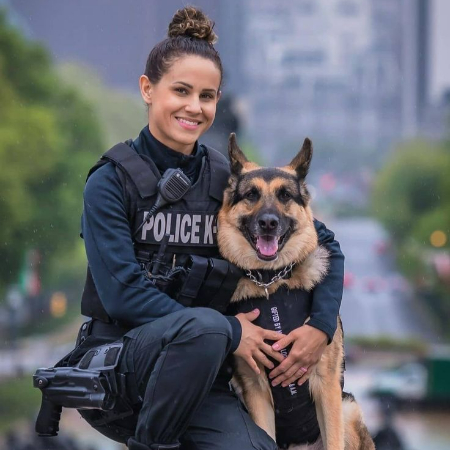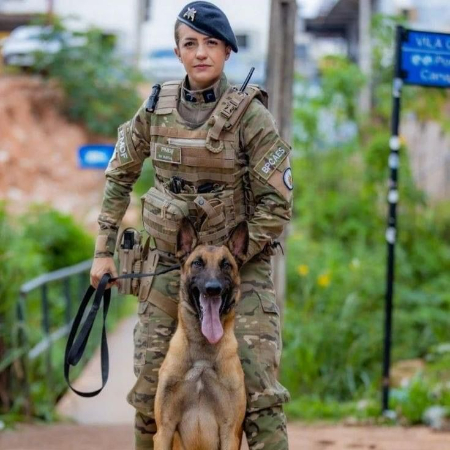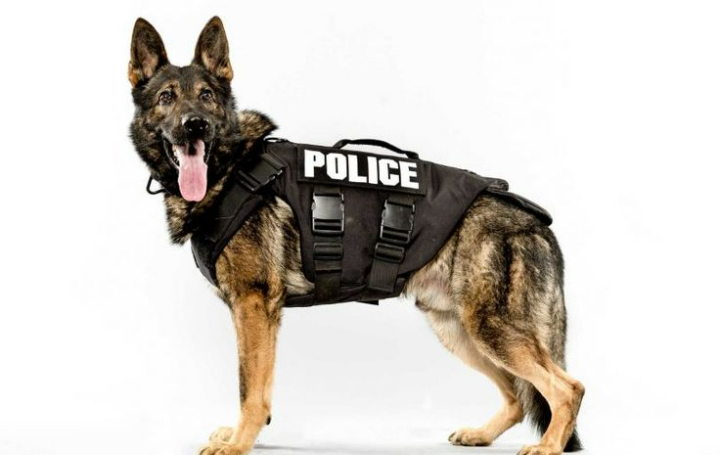“The Role of Dogs in Law Enforcement: How Canines Assist Police and Military Operations”
Over many years, dogs have been devoted members of human society, growing up with us and becoming indispensable allies in a variety of endeavors. In today’s military and law enforcement activities, their intellect, devotion, and keen senses have made them invaluable.
Dogs play an essential role in maintaining national security and public safety, from tracking criminals to spotting explosives. We examine the special skills, training regimen, and varied responsibilities that police and military dogs play in both law enforcement and military environments in this article.
The History of Canines in Law Enforcement
Although it has been done for centuries, the use of dogs in military and law enforcement operations was formalized in the 19th century. One of the first significant cases of canine help in criminal investigations occurred in 1888 when British officials used bloodhounds to hunt for the elusive culprit in the famed Jack the Ripper case. As early as the 1900s, European nations like Belgium and Germany started incorporating dogs into their police operations, formally acknowledging the usefulness of these animals for duties like policing and catching criminals.

Dogs were employed by the military in both World Wars I and II, mostly as sentries, couriers, and search-and-rescue personnel. Specialized breeds are being trained for difficult tasks like bomb detection and covert operations, reflecting the tremendous expansion of their functions over time.
Canine Abilities that Aid Law Enforcement
Canines are especially well-suited for law enforcement and military operations due to a variety of physical and behavioral characteristics. Key competencies that increase their efficacy include the following:
Superb Smell: Dogs are thought to have 40–50 times the strength of a human’s sense of smell. With their keen sense of smell, they can identify things like bombs, drugs, and even minute amounts of human odor during search and rescue missions. Whether there is an illicit drug cache or a hidden bomb, K9s can be trained to detect certain scents and notify their handlers of them.
Greater Hearing: Dogs have a significantly wider hearing range than humans, spanning from 40 Hz to 60 kHz, compared to 20 Hz to 20 kHz. Due to their increased aural sensitivity, they are able to recognize sounds much earlier than their human counterparts, such as distant gunfire or approaching footfall.
Agility and Speed: Canines are adept climbers and swift runners, which helps them track down and capture criminals even in challenging environments. They can also move quickly through confined places, deep forests, and cities that may be off-limits to people thanks to their dexterity and speed.
Protective and Loyal Natural Instincts: Dogs have a strong sense of loyalty to their masters and the teams they work with. They are notably useful in high-risk law enforcement and military circumstances because of their bravery and loyalty, which frequently lead them to put themselves in danger to protect others.
Training Police and Military Dogs
Canines go through demanding training programs designed to meet the unique requirements of the law enforcement or military unit they will serve in order to harness their innate abilities. When they are 12 to 18 months old, police canines, often known as K9s, usually start training early. Breeds that are frequently utilized are Labrador Retrievers, Dutch Shepherds, German Shepherds, and Belgian Malinois; these breeds are selected for their intelligence, flexibility, and work ethic.

Basic Obedience Training: Basic obedience training is necessary to make sure dogs obey directions and get along with their handlers before they are put on specialized tasks. In order to make sure the dog is obedient and disciplined in high-stress scenarios, this phase includes instructions like sit, remain, heel, and come.
Specialized Training: Following their completion of basic obedience training, dogs receive specialized training for a variety of tasks, like as tracking, bomb detection, drug detection, or search and rescue missions. Dogs are exposed to the odors of different explosives during bomb detection training, for instance, and are trained to recognize these smells in everyday settings. A dog’s career is spent consistently improving this kind of training, which often takes several months.
Handler Bonding: The establishment of a deep bond between a dog and its handler is considered to be one of the most important components of training. This relationship makes it possible for the dog to follow its handler’s instructions and perform well even in challenging or dangerous situations. In addition to teaching dogs to trust and obey their handlers without question, handlers also teach their canines how to read body language and signals.
Roles of Police and Military Dogs
Due to their adaptability and the operational requirements of their units, police, and military dogs can play a wide range of duties. These canines perform the following main roles:
Detection of Narcotics and Explosives: One of the most frequent uses of police dogs is the detection of explosives and illegal substances. Drug-sniffing dogs are regularly used to find drugs at border crossings, airports, and regular traffic stops. In a similar vein, bomb-sniffing dogs are employed to maintain security at airports, government buildings, and high-profile events.
Patrolling and Arresting: Dogs are frequently utilized by law enforcement to patrol the streets, particularly when they work night shifts. Not only may their presence prevent crime, but they are also used to track down and arrest criminals when needed. Biting and holding offenders until authorities can safely intervene is one way that K9s can be trained to subdue them.
Search and Rescue: Dogs are very helpful in finding stranded survivors in emergency situations like earthquakes or building collapses. Search and rescue teams can locate people who might go undiscovered otherwise thanks to their capacity to detect human scent amid debris or challenging terrain.
Combat Operations: Dogs are frequently employed in battle zones by the military to help with reconnaissance, tracking, and the detection of enemy troops or weapon caches. By detecting explosives or ambushing adversaries in hazardous situations, specially trained military working dogs (MWDs) have proven invaluable in operations against terrorist organizations and rebels.
Protection and Sentry Duties: Dogs are frequently used to patrol military sites and other high-security areas for protection and sentry duties. They notice hazards well in advance of human workers, which makes them perfect sentries thanks to their sharp senses. Canines provide as an extra layer of protection in various capacities, assisting human guards.
The Emotional and Psychological Support of Canines

The officers and soldiers who work with canines gain greatly from their emotional and psychological qualities in addition to their physical attributes. Particularly in high-stakes situations like battle zones or during protracted law enforcement operations, their presence can bolster morale and lessen tension. As they see their dogs as friends as well as coworkers, handlers frequently form strong emotional ties with them.
Challenges and Considerations
The physical and mental strain of their occupations is one of the difficulties faced by working dogs, notwithstanding their efficiency. Similar to human law enforcement officials, canines that have experienced tragic incidents may experience stress, exhaustion, or even post-traumatic stress disorder (PTSD). Their longevity and overall health depend on us making sure they receive regular veterinary care, have enough relaxation, and plan for retirement.
Conclusion
With many of their skills surpassing those of humans, dogs remain an essential component of military and law enforcement operations around the globe. These canine warriors are invaluable to preserving national security and public safety, whether they are tracking down criminals, finding survivors in disaster areas, or smelling out explosives.
Together with their intense training and strong relationships with their handlers, their special talents make them priceless members of any team they work with. Though their bravery, loyalty, and unmatched senses guarantee that dogs will continue to lead law enforcement and military operations for years to come, it is inevitable that they will continue to adapt to new difficulties as technology progresses.
Tags










